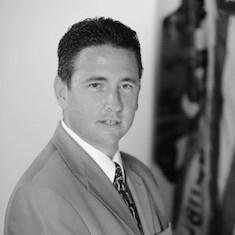Ahead of his presentation at Public Sector Network’s HR Innovation Virtual Event on March 10th, we spoke with Brendan Murphy - Chief of Administration for California’s Department of Human Resources (known as CalHR) - to explore his career in public service, his perspective on effective leadership, and the on-going impact of COVID-19 on CalHR – among other things.
About Brendan:
With a career spanning nearly 20 years across both the public and private sectors – CalHR's Brendan Murphy has been a leader at spearheading effective change and ensuring that his team remain motivated and engaged. With a background spanning Finance and Emergency Management – Brendan has experience and expertise that seems tailor-made for our current crisis.

Q1:
Brendan – you have had a very varied career - spanning private and public sector leadership in various roles. What drew you to public service?
A1:
Originally, I was drawn to public service to help people. I started in public safety on law enforcement and corrections assignments. The draw for me was really to keep people safe, however as I understood the system more I saw the chance to impact more citizens of California by having influence over the policies being enacted, so I took a role over criminal justice policy at the California Department of Finance (the CA equivalent of the Office Management and Budget at the Federal Level). In this role not only did I have to defend the Governor’s Budget in testimony in front of both Houses of the Legislature but I also had to put the proposals together in coordination with the Governor’s Office and other state agencies. Additionally, in this role I commented on over 200 legislative bills a year having to do with new/existing crimes across every possible issue area. After seeing the influence policy can have over the issues I realized that at the end of the day running a state agency is how the policy I was creating was/is enacted, so I started working at running various programs and a few different state agencies.

Q2:
As a leader, your role entails a significant focus on people, culture, and getting the best out of your team. How do you approach getting their buy-in and engagement as it pertains to advancing state-wide initiatives?
A2:
Buy-in and engagement can be tricky no matter the project whether it is state-wide, department-wide, or division-wide. If I can define the ‘why’ for most people, I have found that I can get them to engage. I have even found that with most team members, I don’t have to get them to believe in the ‘why’ I just have to get them to understand that there is a why. A prime example of this aspect was a large-scale accounting information technology project that dramatically changed the way budgets and accounting would be done at the State level. Many departments didn’t understand why things had to change, however as an executive at Finance at the time, it was my job to get departments to implement the new system in the most systematic process possible.
We focused on the why, in all of our discussions and presentations with departments, “our old system is almost 40-years old nobody outside of the employees trained by the state can support the system, currently we are running a massive risk of critical accounting failure. Can you imagine what would happen if the current system failed and we couldn’t issue checks to all state employees on the first?” Usually explaining the why seemed to get people to buy-in to completing the project. Finally, the other part of buy-in and getting the best out of staff, that I try to remember, is change is hard for most people. So, new projects and major statewide changes to the ‘way it has always been’ are hard for most people. In an attempt to make people as comfortable as possible with change, I try not to forget to explain the why and answer questions as openly and honestly as I can to really get everyone invested in the project and outcomes.
Q3 :
2020 was quite the year. block-paddingCan you share with us a perspective, or a lesson learned, that you didn’t have on January 1st, 2020 – but that you hold today? How has the last year changed your outlook?
A3:
In 2020, I learned that a major part of any disaster response is explaining to all citizens (and in the case of 2020 explaining to the entire world) that we must help our neighbor in times of need. People really have a hard time understanding the ‘it takes a village’ concept. I was one of two executive sponsors of the California pandemic plan in 2009, which means that I have literally read every page of the plan and edited most of them. One major underlying assumption of the 2009 California pandemic plan was that citizens of California and every state would understand that living was going to have to be altered until the pandemic was over. Most likely your individual living conditions would be altered across your city, county, state, region, country, and most likely across the world. What I learned in 2020 is that there was a very large segment of the American population that was unable to comprehend that actions taken to address a pandemic in California help people in Oklahoma, Connecticut, Europe, and Latin America. The world, our world, is really pretty small and many, many, people really don’t understand how interconnected we as humans are to all or many of the other states and regions in our own country, let alone the other countries of the world.
Q4:
With so many varied programs and initiatives currently being pursued across the State of California, what initiative would you point to as being a major game-changer for State employees? What impact could the State’s workforce expect?

A4:
California, mostly because of the pandemic, has had a major shift to telework, and the Governor has thrown down a gauntlet to see how we can re-envision state civil service in an era of interconnectedness and telework possibilities. Over the next few years, I expect that we will find a considerable number of positions that can be done remotely and begin the process of moving many staff to a telework environment where the staff can come into the office and check-in to an in-office workstation for the day and work from the office every so often. Many agencies in the federal government have embraced some aspect of telework and I expect that California will keep a major telework emphasis post pandemic.
Q5:
Pulling out your magic 8-ball – Where do you see the human resources practice in 5-years? How will innovation continue to impact our day-to-day lives as we interact with our employers? What aspects of the COVID-19 ‘new normal’ do you expect we will continue to practice?
A5:
Human resources practice in 5-years will have an even greater focus on Diversity, Equity and Inclusion (DEI). It seems that with each study the results are clear office environments across industries have better results when DEI is ingrained in the human resources processes at all levels. I don’t mean any window dressing diversity initiatives here, I think the human resources offices that are successful with DEI will massively improve results for their companies and as such, all human resources shops will need to improve processes related to DEI.
Innovation should continue (hopefully) to expedite the more typical processes of human resources. Many companies have already gone to amazing online systems to help with benefits, timekeeping, and pay, however there are many companies that have not seen the light yet. The easier we make these type of HR processes for the HR staff, the more time HR can spend finding the best and most highly qualified candidates with diverse perspectives to recruit for openings.
Unfortunately, for somebody like me who is a people person I think Covid-19 has put a real hiccup in the classic in-person conference. I expect that more and more, not all, but many more conferences will be held virtually. It can keep costs down for the conference producers and increase the efficiency of attendees with significantly less travel time for some attendees. I’m not sure how I feel about this change yet as I sit here typing answers to interview questions I would probably do better answering live.

Q6:
In closing - what would you say to the next generation of public sector leaders, and those currently considering a career in public service?
A6:
Having been in both the private sector and (mostly) in the public sector, I encourage everyone who is interested to jump into the public sector and give it a try. I am a firm believer in that the public sector quite literally is for everyone. Almost everybody I have met in business could find a position they would like in the public sector. Bottom line, there is no employer who does as many varied things as the public sector. Literally, everyone can find a job that they might enjoy in the public sector. As long as I’m closing I am going to take the time here to make a pitch for a national service pledge that helps students pay back or forgive their student debt for working in service to others across a number of non-profit and public sector employers. I believe this would go a long way to helping the public sector recruit the best, brightest and most diverse candidates to work for all of our citizens.




















